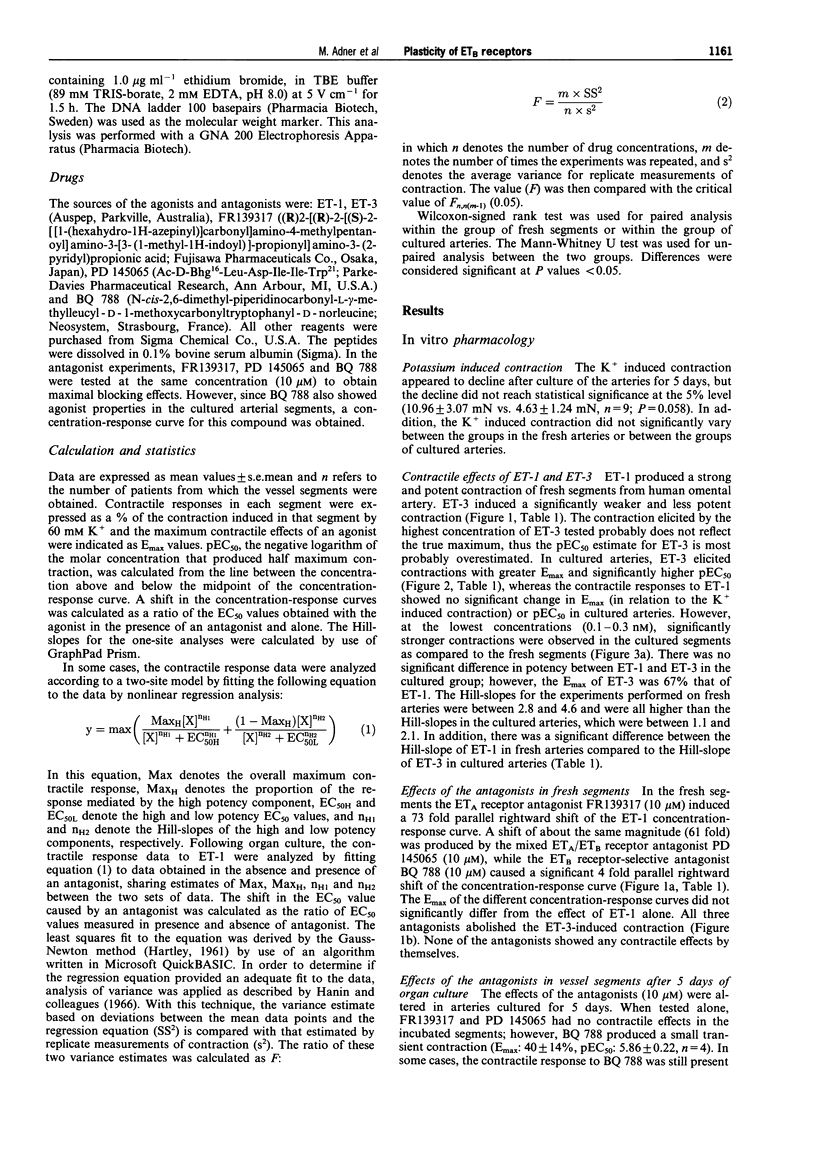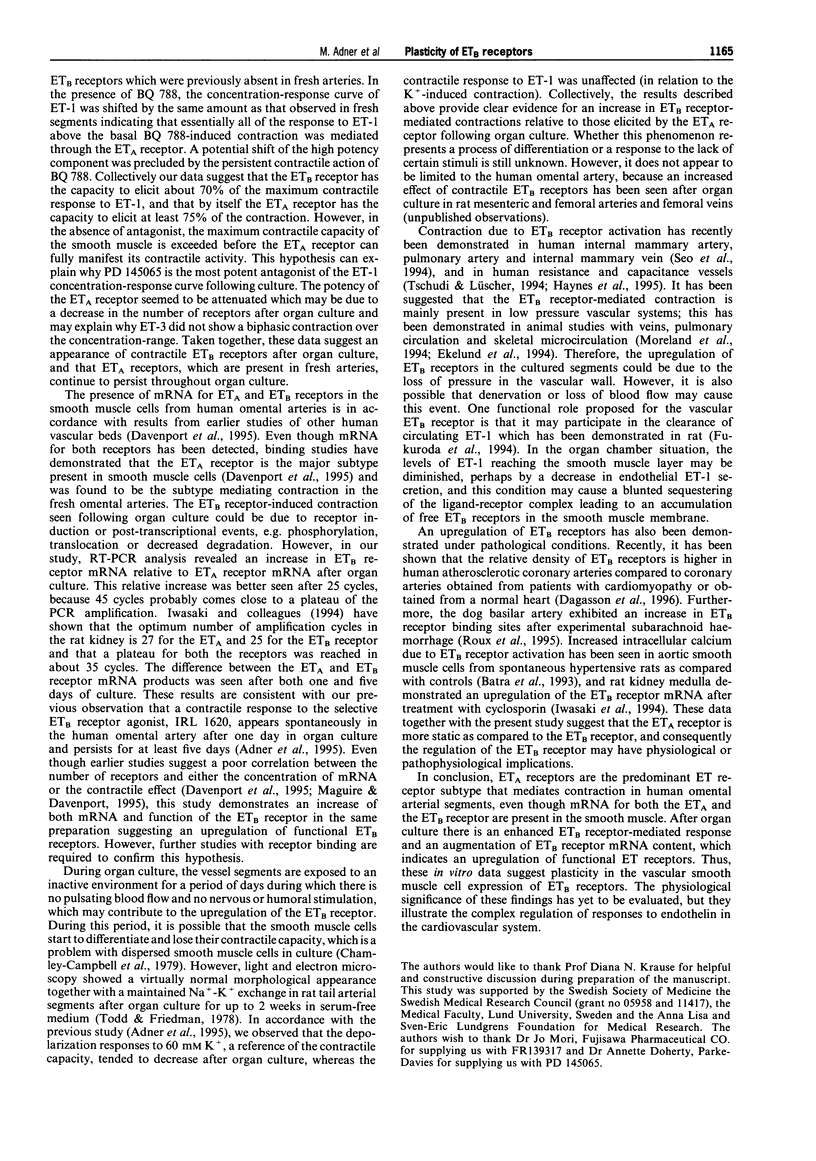Abstract
1. The pharmacology and mRNA expression of endothelin (ET) receptors in human omental arteries were characterized by use of functional contractile assays and the reverse transcriptase-polymerase chain reaction (RT-PCR). 2. In freshly obtained segments of human omental arteries, ET-1 and ET-3 induced concentration-dependent contractions which were normalized to the response produced by 60 mM K+. ET-1 produced a maximum contraction (Emax) amounting to 151 +/- 17% of the K+ response. The pEC50 for this agonist was 8.64 +/- 0.17. The effect of ET-3 was less pronounced (Emax: 71 +/- 22% and pEC50: 6.69 +/- 0.17) than that of ET-1. The ET receptors involved were characterized with FR139317 (a selective ETA receptor antagonist), PD 145065 (a mixed ETA and ETB receptor antagonist) and BQ 788 (an ETB receptor antagonist). A high concentration of these antagonists (10 microM) abolished the contractile responses to ET-3, and produced a parallel rightward shift of the ET-1 concentration-response curve without changing the maximal effect. FR139317 and PD 145065 were equally effective while BQ 788 was much less effective. This is consistent with ETA receptors mediating contraction in human omental arteries. 3. Arterial segments cultured for 5 days in serum-free Dulbecco's medium at 37 degrees C under sterile and humidified conditions retained contractility although responses to 60 mM K+ were somewhat reduced. ET-3 was significantly more potent in the cultured arteries (pEC50: 8.56 +/- 0.15) and achieved a greater maximum effect (Emax: 116 +/- 19%). Responses were not antagonised by FR139317 but were competitively blocked by PD 145065 and BQ 788 with the latter antagonist being the more potent. In contrast Emax (179 +/- 17%) and pEC50 (8.66 +/- 0.23) values for ET-1 were not significantly different from those obtained with fresh arteries. PD 145065 still demonstrated a rightward shift of the ET-1-induced concentration-response curve, whereas FR139317 and BQ 788 caused non-significant shifts. These findings suggest that functional ETB receptors contribute significantly to the endothelin contractile response in cultured arteries. 4. Two-site analysis of the ET-1 induced concentration-response curve from cultured arteries suggests that ETB receptors, at the high potency component, and ETA receptors, at the low potency component, contribute both to the contractile response in relative proportion of 70% and 30%, respectively. Further analysis suggested that the ETA receptor would be capable of evoking at least 75% of the ET-1 contraction in the absence of ETB receptors, although with a lower potency as compared to fresh arteries. 5. Electrophoresis of RT-PCR products from the smooth muscle layer of freshly obtained human arteries indicated the presence of mRNA for both ETA and ETB receptors. Arteries cultured for 1 and 5 days demonstrated an increase of mRNA for the ETB receptor as compared to the ETA receptor. The identities of the PCR products were verified by restriction enzyme digestion. 6. In freshly obtained human omental arteries, the contractile effects of endothelins appear to be mediated predominantly by the ETA receptor subtype, with a negligible contribution by ETB receptors. Cultured arterial segments, however, exhibited a substantial ETB receptor mediated contractile response and an increase in ETB receptor mRNA content, consistent with an upregulation of functional ETB receptors. These in vitro data suggest plasticity in the smooth muscle cell expression of contractile ETB receptors.
Full text
PDF







Images in this article
Selected References
These references are in PubMed. This may not be the complete list of references from this article.
- Adner M., Erlinge D., Nilsson L., Edvinsson L. Upregulation of a non-ETA receptor in human arteries in vitro. J Cardiovasc Pharmacol. 1995;26 (Suppl 3):S314–S316. [PubMed] [Google Scholar]
- Arai H., Hori S., Aramori I., Ohkubo H., Nakanishi S. Cloning and expression of a cDNA encoding an endothelin receptor. Nature. 1990 Dec 20;348(6303):730–732. doi: 10.1038/348730a0. [DOI] [PubMed] [Google Scholar]
- Arai H., Nakao K., Takaya K., Hosoda K., Ogawa Y., Nakanishi S., Imura H. The human endothelin-B receptor gene. Structural organization and chromosomal assignment. J Biol Chem. 1993 Feb 15;268(5):3463–3470. [PubMed] [Google Scholar]
- Batra V. K., McNeill J. R., Xu Y., Wilson T. W., Gopalakrishnan V. ETB receptors on aortic smooth muscle cells of spontaneously hypertensive rats. Am J Physiol. 1993 Feb;264(2 Pt 1):C479–C484. doi: 10.1152/ajpcell.1993.264.2.C479. [DOI] [PubMed] [Google Scholar]
- Chamley-Campbell J., Campbell G. R., Ross R. The smooth muscle cell in culture. Physiol Rev. 1979 Jan;59(1):1–61. doi: 10.1152/physrev.1979.59.1.1. [DOI] [PubMed] [Google Scholar]
- Chomczynski P., Sacchi N. Single-step method of RNA isolation by acid guanidinium thiocyanate-phenol-chloroform extraction. Anal Biochem. 1987 Apr;162(1):156–159. doi: 10.1006/abio.1987.9999. [DOI] [PubMed] [Google Scholar]
- Clozel M., Gray G. A., Breu V., Löffler B. M., Osterwalder R. The endothelin ETB receptor mediates both vasodilation and vasoconstriction in vivo. Biochem Biophys Res Commun. 1992 Jul 31;186(2):867–873. doi: 10.1016/0006-291x(92)90826-7. [DOI] [PubMed] [Google Scholar]
- Dagassan P. H., Breu V., Clozel M., Künzli A., Vogt P., Turina M., Kiowski W., Clozel J. P. Up-regulation of endothelin-B receptors in atherosclerotic human coronary arteries. J Cardiovasc Pharmacol. 1996 Jan;27(1):147–153. doi: 10.1097/00005344-199601000-00023. [DOI] [PubMed] [Google Scholar]
- Davenport A. P., O'Reilly G., Kuc R. E. Endothelin ETA and ETB mRNA and receptors expressed by smooth muscle in the human vasculature: majority of the ETA sub-type. Br J Pharmacol. 1995 Mar;114(6):1110–1116. doi: 10.1111/j.1476-5381.1995.tb13322.x. [DOI] [PMC free article] [PubMed] [Google Scholar]
- Doherty A. M., Cody W. L., He J. X., DePue P. L., Cheng X. M., Welch K. M., Flynn M. A., Reynolds E. E., LaDouceur D. M., Davis L. S. In vitro and in vivo studies with a series of hexapeptide endothelin antagonists. J Cardiovasc Pharmacol. 1993;22 (Suppl 8):S98–102. doi: 10.1097/00005344-199322008-00027. [DOI] [PubMed] [Google Scholar]
- Ekelund U., Adner M., Edvinsson L., Mellander S. Effects of selective ETB-receptor stimulation on arterial, venous and capillary functions in cat skeletal muscle. Br J Pharmacol. 1994 Jul;112(3):887–894. doi: 10.1111/j.1476-5381.1994.tb13163.x. [DOI] [PMC free article] [PubMed] [Google Scholar]
- Fukuroda T., Fujikawa T., Ozaki S., Ishikawa K., Yano M., Nishikibe M. Clearance of circulating endothelin-1 by ETB receptors in rats. Biochem Biophys Res Commun. 1994 Mar 30;199(3):1461–1465. doi: 10.1006/bbrc.1994.1395. [DOI] [PubMed] [Google Scholar]
- Hanin I., Jenden D. J., Cho A. K. The influence of pH on the muscarinic action of oxotremorine, arecoline, pilocarpine, and their quaternary ammonium analogs. Mol Pharmacol. 1966 Jul;2(4):352–359. [PubMed] [Google Scholar]
- Haynes W. G., Strachan F. E., Webb D. J. Endothelin ETA and ETB receptors cause vasoconstriction of human resistance and capacitance vessels in vivo. Circulation. 1995 Aug 1;92(3):357–363. doi: 10.1161/01.cir.92.3.357. [DOI] [PubMed] [Google Scholar]
- Hirata Y., Yoshimi H., Takaichi S., Yanagisawa M., Masaki T. Binding and receptor down-regulation of a novel vasoconstrictor endothelin in cultured rat vascular smooth muscle cells. FEBS Lett. 1988 Oct 24;239(1):13–17. doi: 10.1016/0014-5793(88)80536-2. [DOI] [PubMed] [Google Scholar]
- Hosoda K., Nakao K., Tamura N., Arai H., Ogawa Y., Suga S., Nakanishi S., Imura H. Organization, structure, chromosomal assignment, and expression of the gene encoding the human endothelin-A receptor. J Biol Chem. 1992 Sep 15;267(26):18797–18804. [PubMed] [Google Scholar]
- Högestätt E. D., Andersson K. E., Edvinsson L. Mechanical properties of rat cerebral arteries as studied by a sensitive device for recording of mechanical activity in isolated small blood vessels. Acta Physiol Scand. 1983 Jan;117(1):49–61. doi: 10.1111/j.1748-1716.1983.tb07178.x. [DOI] [PubMed] [Google Scholar]
- Inoue A., Yanagisawa M., Kimura S., Kasuya Y., Miyauchi T., Goto K., Masaki T. The human endothelin family: three structurally and pharmacologically distinct isopeptides predicted by three separate genes. Proc Natl Acad Sci U S A. 1989 Apr;86(8):2863–2867. doi: 10.1073/pnas.86.8.2863. [DOI] [PMC free article] [PubMed] [Google Scholar]
- Ishikawa K., Ihara M., Noguchi K., Mase T., Mino N., Saeki T., Fukuroda T., Fukami T., Ozaki S., Nagase T. Biochemical and pharmacological profile of a potent and selective endothelin B-receptor antagonist, BQ-788. Proc Natl Acad Sci U S A. 1994 May 24;91(11):4892–4896. doi: 10.1073/pnas.91.11.4892. [DOI] [PMC free article] [PubMed] [Google Scholar]
- Iwasaki S., Homma T., Kon V. Site specific regulation in the kidney of endothelin and its receptor subtypes by cyclosporine. Kidney Int. 1994 Feb;45(2):592–597. doi: 10.1038/ki.1994.77. [DOI] [PubMed] [Google Scholar]
- Karaki H., Sudjarwo S. A., Hori M. Novel antagonist of endothelin ETB1 and ETB2 receptors, BQ-788: effects on blood vessel and small intestine. Biochem Biophys Res Commun. 1994 Nov 30;205(1):168–173. doi: 10.1006/bbrc.1994.2645. [DOI] [PubMed] [Google Scholar]
- Maguire J. J., Davenport A. P. ETA receptor-mediated constrictor responses to endothelin peptides in human blood vessels in vitro. Br J Pharmacol. 1995 May;115(1):191–197. doi: 10.1111/j.1476-5381.1995.tb16338.x. [DOI] [PMC free article] [PubMed] [Google Scholar]
- Masaki T., Vane J. R., Vanhoutte P. M. International Union of Pharmacology nomenclature of endothelin receptors. Pharmacol Rev. 1994 Jun;46(2):137–142. [PubMed] [Google Scholar]
- Moreland S., McMullen D., Abboa-Offei B., Seymour A. Evidence for a differential location of vasoconstrictor endothelin receptors in the vasculature. Br J Pharmacol. 1994 Jun;112(2):704–708. doi: 10.1111/j.1476-5381.1994.tb13133.x. [DOI] [PMC free article] [PubMed] [Google Scholar]
- O'Reilly G., Charnock-Jones D. S., Davenport A. P., Cameron I. T., Smith S. K. Presence of messenger ribonucleic acid for endothelin-1, endothelin-2, and endothelin-3 in human endometrium and a change in the ratio of ETA and ETB receptor subtype across the menstrual cycle. J Clin Endocrinol Metab. 1992 Dec;75(6):1545–1549. doi: 10.1210/jcem.75.6.1464662. [DOI] [PubMed] [Google Scholar]
- Riezebos J., Watts I. S., Vallance P. J. Endothelin receptors mediating functional responses in human small arteries and veins. Br J Pharmacol. 1994 Feb;111(2):609–615. doi: 10.1111/j.1476-5381.1994.tb14780.x. [DOI] [PMC free article] [PubMed] [Google Scholar]
- Roux S., Löffler B. M., Gray G. A., Sprecher U., Clozel M., Clozel J. P. The role of endothelin in experimental cerebral vasospasm. Neurosurgery. 1995 Jul;37(1):78–86. doi: 10.1227/00006123-199507000-00012. [DOI] [PubMed] [Google Scholar]
- Sakurai T., Yanagisawa M., Takuwa Y., Miyazaki H., Kimura S., Goto K., Masaki T. Cloning of a cDNA encoding a non-isopeptide-selective subtype of the endothelin receptor. Nature. 1990 Dec 20;348(6303):732–735. doi: 10.1038/348732a0. [DOI] [PubMed] [Google Scholar]
- Seo B., Oemar B. S., Siebenmann R., von Segesser L., Lüscher T. F. Both ETA and ETB receptors mediate contraction to endothelin-1 in human blood vessels. Circulation. 1994 Mar;89(3):1203–1208. doi: 10.1161/01.cir.89.3.1203. [DOI] [PubMed] [Google Scholar]
- Sogabe K., Nirei H., Shoubo M., Nomoto A., Ao S., Notsu Y., Ono T. Pharmacological profile of FR139317, a novel, potent endothelin ETA receptor antagonist. J Pharmacol Exp Ther. 1993 Mar;264(3):1040–1046. [PubMed] [Google Scholar]
- Todd M. E., Friedman S. M. The rat-tail artery maintained in culture: an experimental model. In Vitro. 1978 Sep;14(9):757–770. doi: 10.1007/BF02617969. [DOI] [PubMed] [Google Scholar]
- Tschudi M. R., Lüscher T. F. Characterization of contractile endothelin and angiotensin receptors in human resistance arteries: evidence for two endothelin and one angiotensin receptor. Biochem Biophys Res Commun. 1994 Oct 28;204(2):685–690. doi: 10.1006/bbrc.1994.2514. [DOI] [PubMed] [Google Scholar]
- Wagner O. F., Christ G., Wojta J., Vierhapper H., Parzer S., Nowotny P. J., Schneider B., Waldhäusl W., Binder B. R. Polar secretion of endothelin-1 by cultured endothelial cells. J Biol Chem. 1992 Aug 15;267(23):16066–16068. [PubMed] [Google Scholar]
- Wenzel R. R., Noll G., Lüscher T. F. Endothelin receptor antagonists inhibit endothelin in human skin microcirculation. Hypertension. 1994 May;23(5):581–586. doi: 10.1161/01.hyp.23.5.581. [DOI] [PubMed] [Google Scholar]
- Yanagisawa M., Kurihara H., Kimura S., Tomobe Y., Kobayashi M., Mitsui Y., Yazaki Y., Goto K., Masaki T. A novel potent vasoconstrictor peptide produced by vascular endothelial cells. Nature. 1988 Mar 31;332(6163):411–415. doi: 10.1038/332411a0. [DOI] [PubMed] [Google Scholar]
- de Nucci G., Thomas R., D'Orleans-Juste P., Antunes E., Walder C., Warner T. D., Vane J. R. Pressor effects of circulating endothelin are limited by its removal in the pulmonary circulation and by the release of prostacyclin and endothelium-derived relaxing factor. Proc Natl Acad Sci U S A. 1988 Dec;85(24):9797–9800. doi: 10.1073/pnas.85.24.9797. [DOI] [PMC free article] [PubMed] [Google Scholar]



